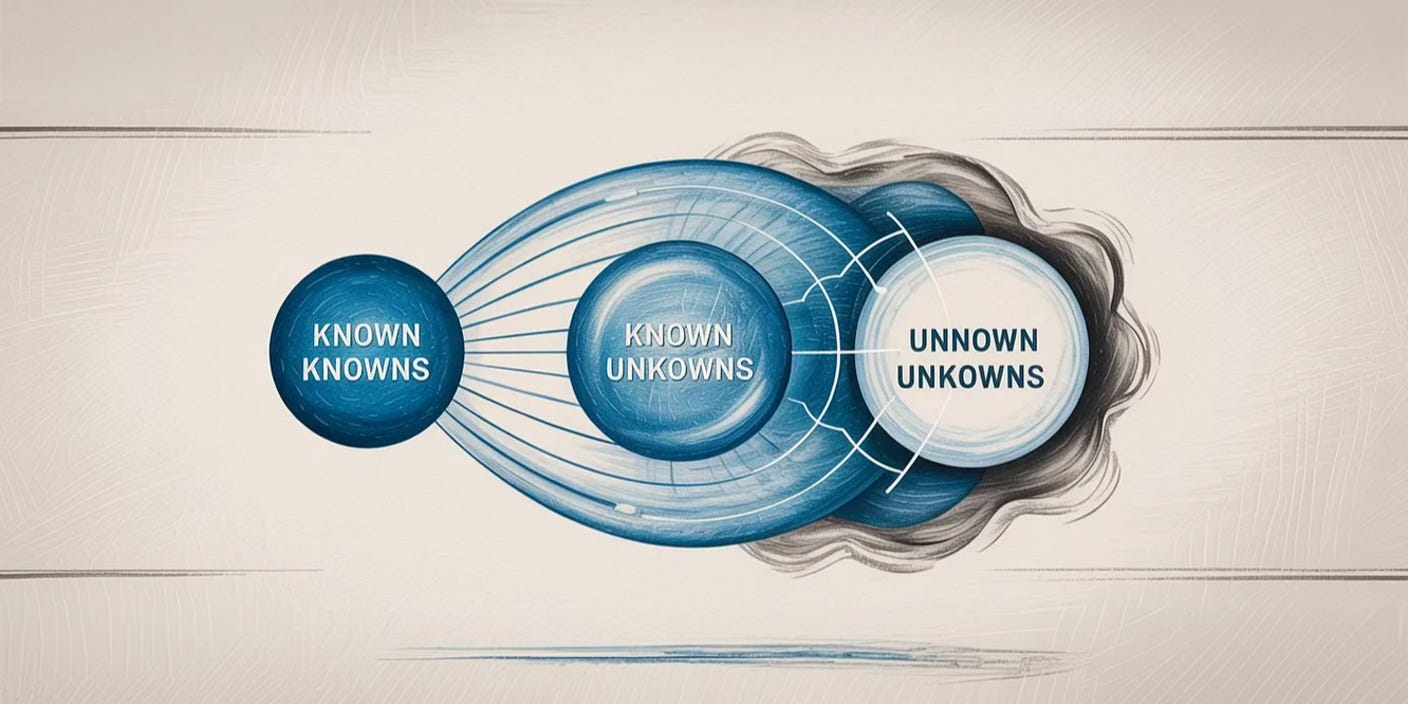Known Knowns to Unknown Unknowns: Not All Volatility is Created Equal
Understanding of how markets price different types of uncertainty
Volatility is fundamentally about pricing uncertainty. But not all uncertainty is created equal.
The CI Volatility Mindset
The most successful volatility firms understand that each category requires different approaches:
Known knowns are about execution and timing
Unknown knowns are about research and pattern recognition
Unknown unknowns are about survival and capitalizing on chaos
Known Knowns: When Markets See It Coming
Known knowns are volatility events that markets are fully aware of and can prepare for. These are scheduled events with predictable timing, even if the outcome remains uncertain.
Examples of Known Knowns:
Earnings releases: Every quarter, companies report results on known dates
Federal Reserve meetings: FOMC decisions occur on a predetermined schedule
Economic data releases: NFP, CPI, GDP reports have set release dates
Central bank decisions: ECB, BOJ, and other major central banks follow known calendars
Markets are remarkably efficient at pricing known volatility events. Options markets will show elevated implied volatility leading up to earnings announcements.
The challenge with known knowns isn’t predicting that volatility will occur, it’s predicting whether realized volatility will exceed what’s already priced in.
Known Unknowns: The Overlooked Catalysts
Known unknowns represent events that are theoretically knowable but somehow escape market attention or are systematically underpriced.
These are situations where the information exists in the market, but collective psychology or structural biases cause traders to ignore or underweight the probability of significant outcomes.
Examples of Known Unknowns:
Geopolitical tensions: Escalating conflicts that simmer in the background until they explode
Tariff Impacts: The basic facts are public but the full implications remain systematically unknown.
Natural gas winter/summer demand cycles. Markets know winter demand will be high, but consistently underestimate how other factors such as storage ratesimpact price.
Known unknowns often present the best risk-adjusted returns for volatility firms because they’re systematically underpriced. The key is developing systems to identify these overlooked catalysts and wrapping that catalyst in a convex trade before they become obvious to everyone else.
Unknown Unknowns: The True Volatility Creators
Unknown unknowns are events that markets neither anticipate nor prepare for. These create the most dramatic volatility spikes because they catch the entire market off guard, leading to widespread repricing and forced position unwinding.
Examples of Unknown Unknowns:
Black swan events: 9/11, Fukushima nuclear disaster, initial COVID-19 outbreak
Flash crashes: May 2010 flash crash, CHF unpegging in 2015
Unexpected policy changes: Nixon Shock (1971), Plaza Accord (1985)
Technology failures: Knight Capital trading glitch (2012)
Sudden corporate events: Surprise bankruptcy filings, accounting scandals
Natural disasters: Unexpected earthquakes, hurricanes, volcanic eruptions
Cyber attacks: Major infrastructure or financial system breaches
Why Unknown Unknowns Create Maximum Volatility:
1. No Hedging Preparation Since these events aren’t anticipated, there are no protective positions in place. Portfolios are maximally exposed to the shock.
2. Forced Selling Cascades Unexpected losses trigger margin calls, stop-losses, and risk management systems, creating feedback loops of selling that amplify the initial move.
3. Liquidity Evaporation Market makers and liquidity providers, caught off guard, widen spreads and reduce position sizes, exactly when liquidity is most needed.
4. Correlation Breakdowns Diversification fails as correlations spike toward 1.0. Assets that normally move independently suddenly move together.
5. Volatility Regime Shift These events often mark transitions from low-vol to high-vol market regimes, repricing volatility across all time horizons.
Why This Framework Matters for Investors
Sophisticated volatility firms recognize that navigating the spectrum of uncertainties—known knowns, known unknowns, and unknown unknowns—demands precisely tailored approaches, each calibrated to the unique dynamics of market pricing and risk.
For investors and family offices entrusted with safeguarding and growing wealth across generations, using a firm that has mastered these distinctions is not merely advantageous but an absolute necessity.



